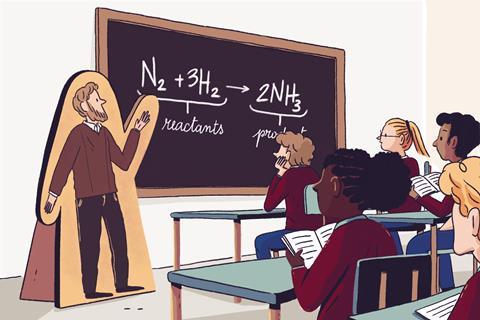Discover why science teachers are in short supply and what schools can do about it

Many UK teachers feel that school science departments are struggling to recruit and retain teachers, and there are hard statistics to back this up. As far back as the mid-2000s, the UK-based Campaign for Science and Engineering (CaSE) presented figures to the UK’s House of Lords showing that a quarter of state secondary schools had no specialist physics teachers, that 10% of secondary school chemistry teachers had no chemistry qualification, and 9% of biology teachers had no biology qualification. CaSE felt then that the shortfall was partly because, as a career, teaching was relatively unattractive to successful science graduates with much higher earning potential elsewhere in industry.
In 2017, a Sutton Trust report highlighted a UK-wide ‘science shortfall’, drawing attention to ‘a consistent failure to attract science graduates into teaching’ over the previous half-decade. The report noted that too many secondary school science teachers didn’t have directly relevant qualifications in ‘their’ subjects.
Many UK teachers feel that school science departments are struggling to recruit and retain teachers, and there are hard statistics to back this up. As far back as the mid-2000s, the UK-based Campaign for Science and Engineering (CaSE) presented figures to the UK’s House of Lords showing that a quarter of state secondary schools had no specialist physics teachers, that 10% of secondary school chemistry teachers had no chemistry qualification, and 9% of biology teachers had no biology qualification. CaSE felt then that the shortfall was partly because, as a career, teaching was relatively unattractive to successful science graduates with much higher earning potential elsewhere in industry.
In 2017, a Sutton Trust report (bit.ly/3GOtc9k) highlighted a UK-wide ‘science shortfall’, drawing attention to ‘a consistent failure to attract science graduates into teaching’ over the previous half-decade. The report noted that too many secondary school science teachers didn’t have directly relevant qualifications in ‘their’ subjects.
‘As a head of science, I couldn’t recruit a physics teacher … we would advertise and get zero applicants’
In a 2020 article on tackling teacher shortages, Annette Farrell from the Royal Society of Chemistry (RSC) Education policy team noted that the RSC was ‘very concerned about ongoing chemistry teacher shortages’. On the eve of the first UK lockdown, an Education Policy Institute report stated that exit rates among newly qualified teachers had been rising every year, reaching 20% after they were qualified for two years and 40% after five years. Rates were even higher among ‘shortage subjects such as maths, sciences and languages’ – rising to 50% after five years.
In a 2020 article on tackling teacher shortages (rsc.li/3u8U8Jm), Annette Farrell from the Royal Society of Chemistry (RSC) Education policy team noted that the RSC was ‘very concerned about ongoing chemistry teacher shortages’. On the eve of the first UK lockdown, an Education Policy Institute report (bit.ly/3UeyRbG) stated that exit rates among newly qualified teachers had been rising every year, reaching 20% after they were qualified for two years and 40% after five years. Rates were even higher among ‘shortage subjects such as maths, sciences and languages’ – rising to 50% after five years.
An ongoing challenge

The situation has not materially improved since the start of the pandemic; the UK teaching profession could be described as a bag with leaks at both ends. In terms of getting new blood into the profession, as of autumn 2022, the Department for Education (DfE) was forecast to have missed its recruitment target for new secondary school teacher trainees for the coming year by about a third, having previously only met it once in over a decade. The exception was the academic year starting autumn 2020, when the lockdown prompted an extra influx of postgraduates into initial teacher training (ITT). But the DfE’s statistics on those who went through ITT in 2020/21 show that 8% did not complete their training – double the percentage of non-finishers compared to the cohort one year earlier.
At the same time, the rate of experienced teachers leaving the profession is also up again, according to a 2022 survey on teacher shortages by the Association of School and College Leaders (ASCL). A disturbing 65% of schools surveyed had experienced recent difficulty retaining their experienced staff, citing the perennial bugbears of the profession – relatively low pay, poor work-life balance and more attractive alternative careers – as causes. Not incidentally, the same survey identifies chemistry in the top third of subjects presenting the greatest recruitment difficulty to ASCL members. And these problems are coming to a head just as an ongoing demographic bulge is set to cause pupil numbers to rise over the next few years, not fall.
The situation has not materially improved since the start of the pandemic; the UK teaching profession could be described as a bag with leaks at both ends. In terms of getting new blood into the profession, as of autumn 2022, the Department for Education (DfE) was forecast to have missed its recruitment target for new secondary school teacher trainees for the coming year by about a third, having previously only met it once in over a decade. The exception was the academic year starting autumn 2020, when the lockdown prompted an extra influx of postgraduates into initial teacher training (ITT). But the DfE’s statistics (bit.ly/3Uko4Nc) on those who went through ITT in 2020/21 show that 8% did not complete their training – double the percentage of non-finishers compared to the cohort one year earlier.
At the same time, the rate of experienced teachers leaving the profession is also up again, according to a 2022 survey on teacher shortages (bit.ly/3XGm44L) by the Association of School and College Leaders (ASCL). A disturbing 65% of schools surveyed had experienced recent difficulty retaining their experienced staff, citing the perennial bugbears of the profession – relatively low pay, poor work-life balance and more attractive alternative careers – as causes. Not incidentally, the same survey identifies chemistry in the top third of subjects presenting the greatest recruitment difficulty to ASCL members. And these problems are coming to a head just as an ongoing demographic bulge is set to cause pupil numbers to rise over the next few years, not fall.
‘To find a science teacher is hard; to appoint a good, experienced and skilled science teacher is almost impossible!’
The above statistics are from the DfE, and therefore relate to England alone. But as Annette noted in her 2020 article, ‘It’s a similar story in Wales, and Scotland is also showing signs of an emerging teacher supply problem.’
Anecdotally, teachers interviewed for this article all spoke of the lack of specialist staff to cover science tuition in schools, whether from the home counties, central England, Scotland or Wales. One physics teacher from Wrexham said they no longer have any chemistry teachers at her current school. A former secondary head of science from Scotland, now working in higher education, had to go to the lengths of being reaccredited by the General Teaching Council of Scotland (GTCS) to fill a vacancy. ‘As a head of science, I couldn’t recruit a physics teacher … we would advertise and get zero applicants. I sent my degree transcript to the GTCS and they confirmed I had enough credits in my degree to teach physics. So, I spent the last year of my teaching career as a physics teacher instead of chemistry.’ The situation nationally can be neatly summed up by one head of department: ‘To find a science teacher is hard; to appoint a good, experienced and skilled science teacher is almost impossible!’
What’s the solution?
In the long run, ITT in science – indeed, ITT generally – needs to be more attractive to postgraduates. As Schools Week reported in September 2022, research from the National Foundation for Educational Research (NFER) highlighted the difference training bursaries can make. The report noted the collapse of ITT applicants in subjects that had their bursary support heavily cut or removed altogether after the 2020/21 training year. By contrast, subjects that maintained their ITT bursary at high levels – or had it cut only slightly, like chemistry – continued to enjoy decent recruitment in 2021/22. However, the retention of a relatively high bursary has not helped physics ITT recruitment over the past three years.
A September 2022 research briefing for the UK House of Commons library reports on the dampening effect of low bursaries on the number of entrants to ITT. This is covered in more detail in Jack Worth’s 2022 Teacher labour market report for the NFER. Jack also highlights an excellent analysis of the impact of bursaries on recruitment on his personal Twitter feed. The implication is clear: schools need to encourage teachers into this challenging profession with financial support.
In the long run, ITT in science – indeed, ITT generally – needs to be more attractive to postgraduates. As Schools Week reported in September 2022 (bit.ly/3ATlZRp), research from the National Foundation for Educational Research (NFER) highlighted the difference training bursaries can make. The report noted the collapse of ITT applicants in subjects that had their bursary support heavily cut or removed altogether after the 2020/21 training year. By contrast, subjects that maintained their ITT bursary at high levels – or had it cut only slightly, like chemistry – continued to enjoy decent recruitment in 2021/22. However, the retention of a relatively high bursary has not helped physics ITT recruitment over the past three years.
A 2022 research briefing for the UK House of Commons library (bit.ly/3UhryzU) reports on the dampening effect of low bursaries on the number of entrants to ITT. This is covered in more detail in Jack Worth’s 2022 Teacher labour market report for the NFER (bit.ly/3XJx29B). The implication is clear: schools need to encourage teachers into this challenging profession with financial support.
We must encourage high-quality teachers from other disciplines to step up and teach subjects they aren’t necessarily trained for
But it takes time for trainee teachers to begin contributing meaningfully to reducing specialist staff shortages. What can be done to alleviate science teacher shortages in the immediate short term? Annette believes we must encourage high-quality teachers from other disciplines to step up and teach subjects they aren’t necessarily trained for. A south Wales teacher positively recounts how two experienced but non-specialist teachers in her school took on science teaching to great effect: ‘They converted to science, but were excellent teachers in their own subjects before they changed – a major factor in their success.’ But she also sounds a note of caution: ‘Changing disciplines is extremely challenging’.
Finally, of course, it’s important to slow the retirement of experienced science teachers. As several of the published sources already quoted in this article assert, pay is a key factor in whether (or not) the services of experienced teachers can be retained. Just before this article went to press, the teaching unions were gearing up to clash with the government over pay. Mary Bousted of the National Education Union points out that, since 2010, inflation has led to a real-term drop in teachers’ salaries, while the existing proposals on teacher pay rises, thanks to the current inflationary climate, will not improve teachers’ salaries in real terms. Tough times – and possibly battles – may lie ahead.
Matt Bell is an author, postman and volunteer tour guide













1 Reader's comment